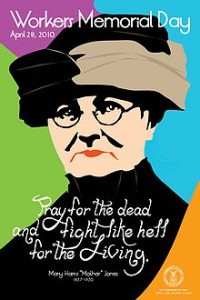“Labor Day recognizes the contributions that workers have made to the strength, prosperity, laws, and well-being of the country.”
Source: Wikipedia on the World Wide Web, September 3, 2018
Mary G. Harris Jones (baptized 1837; died 1930), known as Mother Jones, was an Irish-born American schoolteacher and dressmaker who became a prominent organized labor representative and community organizer. She helped coordinate major strikes and cofounded the Industrial Workers of the World.
Jones worked as a teacher and dressmaker, but after her husband and four children all died of yellow fever in 1867 and her dress shop was destroyed in the Great Chicago Fire of 1871, she began working as an organizer for the Knights of Labor and the United Mine Workers union. From 1897, at about 60 years of age, she was known as Mother Jones. In 1902, she was called “the most dangerous woman in America” for her success in organizing mine workers and their families against the mine owners. In 1903, to protest the lax enforcement of the child labor laws in the Pennsylvania mines and silk mills, she organized a children’s march from Philadelphia to the home of President Theodore Roosevelt in New York.
Important achievements despite prison sentences
During the Paint Creek–Cabin Creek strike of 1912 in West Virginia, Mary Jones arrived in June 1912, speaking and organizing despite a shooting war between United Mine Workers members and the private army of the mine owners. Martial law in the area was declared and rescinded twice before Jones was arrested on 13 February 1913 and brought before a military court. Accused of conspiring to commit murder among other charges, she refused to recognize the legitimacy of her court-martial. She was sentenced to twenty years in the state penitentiary. During house arrest at Mrs. Carney’s Boarding House, she acquired a dangerous case of pneumonia.
After 85 days of confinement, her release coincided with Indiana Senator John W. Kern’s initiation of a Senate investigation into the conditions in the local coal mines. Mary Lee Settle describes Jones at this time in her 1978 novel The Scapegoat. Several months later, she helped organize coal miners in Colorado. Once again she was arrested, served some time in prison, and was escorted from the state in the months prior to the Ludlow Massacre. After the massacre, she was invited to meet face-to-face with the owner of the Ludlow mine, John D. Rockefeller Jr. The meeting prompted Rockefeller to visit the Colorado mines and introduce long-sought reforms.

